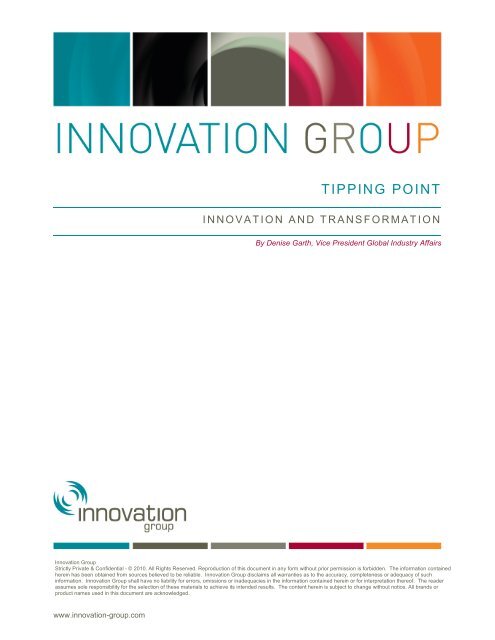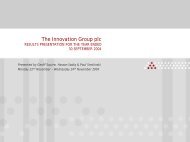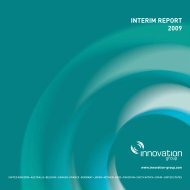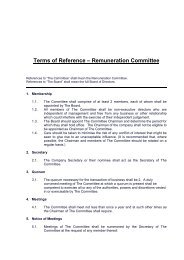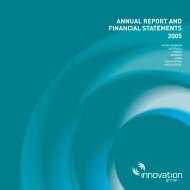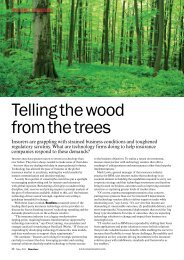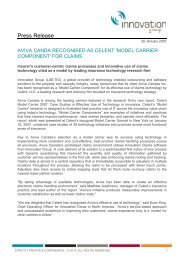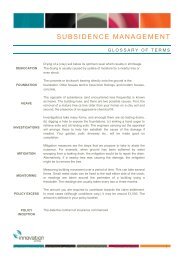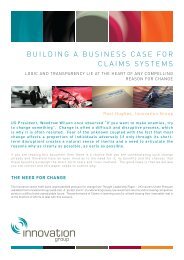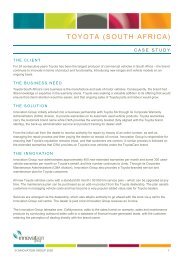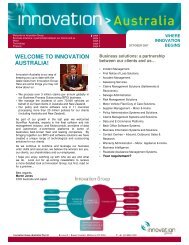Tipping Point Innovation and Transformation Final - Innovation Group
Tipping Point Innovation and Transformation Final - Innovation Group
Tipping Point Innovation and Transformation Final - Innovation Group
You also want an ePaper? Increase the reach of your titles
YUMPU automatically turns print PDFs into web optimized ePapers that Google loves.
<strong>Innovation</strong> <strong>Group</strong><br />
Strictly Private & Confidential - © 2010. All Rights Reserved. Reproduction of this document in any form without prior permission is forbidden. The information contained<br />
herein has been obtained from sources believed to be reliable. <strong>Innovation</strong> <strong>Group</strong> disclaims all warranties as to the accuracy, completeness or adequacy of such<br />
information. <strong>Innovation</strong> <strong>Group</strong> shall have no liability for errors, omissions or inadequacies in the information contained herein or for interpretation thereof. The reader<br />
assumes sole responsibility for the selection of these materials to achieve its intended results. The content herein is subject to change without notice. All br<strong>and</strong>s or<br />
product names used in this document are acknowledged.<br />
www.innovation-group.com<br />
TIPPING POINT<br />
I N N O V A T I O N A N D T R A N S F O R M A T I O N<br />
By Denise Garth, Vice President Global Industry Affairs
T I P P I N G P O I N T … I N N O V A T I O N A N D T R A N S F O R M A T I O N<br />
Malcolm Gladwell’s book “The <strong>Tipping</strong> <strong>Point</strong>”, suggests a tipping point is when an idea, trend, behavior or expectation<br />
crosses a threshold <strong>and</strong> spreads like wildfire. It can change the fundamentals of business <strong>and</strong> be sudden.<br />
History has seen many tipping points. They offered opportunities to use technology, creating innovation <strong>and</strong><br />
transformation. Another “tipping point” is underway.<br />
Carlota Perez, a scholar of technology <strong>and</strong> socio-economic development at Cambridge University, believes from the<br />
Industrial Revolution to the Information Age, there is a consistent pattern in the diffusion of technological revolutions <strong>and</strong><br />
their impact on macro-economic trends. Growth in the economy takes place by successive surges of about half a<br />
century, each driven by a technological revolution. Her analysis of these patterns of revolution, innovation <strong>and</strong><br />
transformation are shown below.<br />
Installation<br />
Industrial<br />
Revolution<br />
1771<br />
Steam &<br />
Railways<br />
1829<br />
Steel, Electricity &<br />
Heavy Engineering<br />
1875<br />
Automobiles, Oil &<br />
Mass Production<br />
1908<br />
Information &<br />
Telecommunications<br />
1971<br />
Collapse &<br />
Readjustment<br />
CANAL PANIC<br />
1797<br />
(Britain)<br />
RAILWAY PANIC 1847<br />
(Britain)<br />
GLOBAL COLLAPSES<br />
OF THE 1890s<br />
(Argentina, Australia, U.S.)<br />
GREAT CRASH<br />
OF 1929<br />
(U.S.)<br />
NASDAQ CRASH OF 2000<br />
& GLOBAL COLLAPSES<br />
(Asia, Argentina, U.S.)<br />
Deployment<br />
• Diffusion of manufacturing with water power<br />
• Full network of waterways (canals, rivers, oceans)<br />
• Development of public companies<br />
• Economies of scale<br />
• Joint stock companies<br />
• Repeal of tariff laws/free trade<br />
• Transcontinental rail, steamships <strong>and</strong> telegraph<br />
• Gold st<strong>and</strong>ard, global finance<br />
• Interstate/international highways <strong>and</strong> airways<br />
• Welfare state, Bretton Woods, IMF, World Bank<br />
• Global, digital telecommunications network<br />
• Institutional framework facilitating globalization<br />
Based on Technological Revolutions <strong>and</strong> Financial Capital:<br />
The Dynamics of Bubbles <strong>and</strong> Golden Ages, Carlota Perez<br />
Ms Perez suggests core radical innovations come first, spawning a wave of interrelated investment. Each such<br />
revolution takes about half a century to spread around the world, <strong>and</strong> is characterized by the two distinct periods:<br />
installation <strong>and</strong> deployment.<br />
The Installation Period lasts years but ends in a speculative financial boom or bubble. It is a time of creative destruction<br />
with the emergence of new technologies into the marketplace, new businesses using these technologies, <strong>and</strong> new<br />
business models.<br />
The bubble collapse leads to a correction. The Deployment Period follows, weaving technology into the fabric of business<br />
<strong>and</strong> society. The deployment period is a time of creative construction <strong>and</strong> institutional re- composition. The new<br />
technologies <strong>and</strong> business paradigms become the norm <strong>and</strong> drive long-term growth <strong>and</strong> expansion of these successful<br />
business models.<br />
Over the past couple of centuries years, we have had a technology revolution every 40 - 60 years, starting with the<br />
Industrial Revolution in 1171; followed by the age of steam <strong>and</strong> coal, iron <strong>and</strong> railways which started in 1829; then steel<br />
<strong>and</strong> heavy engineering (electrical, chemical, civil <strong>and</strong> naval) in 1875; <strong>and</strong> then the automobile in 1908. The current era,<br />
the information technology <strong>and</strong> telecommunications age, started in 1971 represents the fifth major revolution during this<br />
200+ year span.<br />
July 2010 www.innovation-group.com 2 of 8
Today’s crisis, the boom <strong>and</strong> crash came in two episodes; the Internet frenzy ending in the .COM crash <strong>and</strong> the credit<br />
bubbles of 2003-08 resulting in the market crash <strong>and</strong> “great recession”. Ms. Perez suggests the next 2-3 decades will be<br />
the deployment period using new technology to create a new business paradigm based on innovation.<br />
The financial crisis is indeed a “once in a half century event”, but one she suggests it happened four times before over<br />
the last 200+ years. Each technology-based revolution had its unique dynamics, but the historical view provides insight<br />
for insurers as they embrace this disruption, use new technologies like SOA, SaaS, social media, <strong>and</strong> mobile internet<br />
computing to plan their future.<br />
New technologies <strong>and</strong> innovations advocated by entrepreneurs <strong>and</strong> leading companies are the force that creates <strong>and</strong><br />
sustains long-term economic growth, even as this same powerful force creates a new competitive l<strong>and</strong>scape <strong>and</strong><br />
destroys the value of established companies if they do not re-shape their companies.<br />
R E - S H A P I N G T H E I N S U R A N C E I N D U S T R Y<br />
<strong>Innovation</strong> <strong>and</strong> insurance together are viewed as an “oxymoron”. The industry demonstrated innovation during<br />
1960’s/1970’s creating new products, services <strong>and</strong> distribution methods using technology. Early-adoption fueled growth,<br />
exp<strong>and</strong>ed customer access <strong>and</strong> competitive pricing due to more efficient operations. This value has diminished, due to<br />
the “Achilles heel” of legacy solutions <strong>and</strong> models. Once again, innovation <strong>and</strong> disruption are needed for a new round<br />
competition.<br />
Increased competition, cost inflation, changing customer loyalty, <strong>and</strong> decreasing premium growth are pushing the<br />
industry to change its paradigm by re-assessing business models <strong>and</strong> focusing on insurance profitability fundamentals.<br />
Customer expectations, product/services access are influenced by the Internet <strong>and</strong> businesses operating on it.<br />
Information transparency, product choices, behavioral/life-style shifts, <strong>and</strong> social media providing recommendations are<br />
changing consumer mind-sets.<br />
A fundamental power shift is underway, from agent/broker <strong>and</strong> insurer to the consumer. The emergence of<br />
consumerization requires innovation.<br />
Recent research from Global Futures <strong>and</strong> Foresight, Gartner <strong>and</strong> Celent highlight the focus on innovation <strong>and</strong> new<br />
thinking on how to use technology to unleash opportunities.<br />
• <strong>Innovation</strong> is a key differentiator, high priority <strong>and</strong> discussion point among insurers.<br />
• Mash-up business models, combining elements of multiple platforms <strong>and</strong>/or existing models are increasingly<br />
viable.<br />
• The Internet is a critical thread through business strategies <strong>and</strong> innovation <strong>and</strong> must be embraced.<br />
• The Internet radically changed the way people communicate, interact <strong>and</strong> reconfigure their relationship to<br />
business entities.<br />
• Product innovation will be a top priority among leading P&C insurers during the next five years.<br />
• The customer is increasingly powerful relative to the company. Customers are empowered through information<br />
transparency, social-network interactions <strong>and</strong> information availability. Customer intelligence is critical to<br />
determine product <strong>and</strong> service needs.<br />
• Customer experience of convenience <strong>and</strong> quality service levels are expected not desired. Customer innovation<br />
<strong>and</strong> use of new technologies will be critical to support the "consumer of the future."<br />
Long-held, traditional business <strong>and</strong> technology strategies inhibit future success. Companies must embrace new<br />
technology to unleash innovation including:<br />
• Customer <strong>Innovation</strong><br />
• Product <strong>Innovation</strong><br />
• Service/Claims <strong>Innovation</strong><br />
• Business Model <strong>Innovation</strong><br />
July 2010 www.innovation-group.com 3 of 8
How can your company survive the shift underway, but more importantly create a new foundation that leverages the shift<br />
to help your company grow <strong>and</strong> thrive? <strong>Innovation</strong> <strong>and</strong> transformation using new ideas <strong>and</strong> technology.<br />
CUSTOMER INNOVATION<br />
“There has been a fundamental shift in consumer spending patterns, as restraint has become the new mantra. Over the<br />
next 18 months to two years, consumers will make critical decisions about discretionary spending, saving, or paying<br />
down debt, which will have long-term bottom line implications.” - Nielsen Chairman <strong>and</strong> CEO David Calhoun (July 30 th<br />
2009)<br />
Researchers find consumer social attitudes/behaviors are irrevocably altered from the financial crisis. Insurers see<br />
decreased premium from customers switching policies to find lower cost/more value.<br />
Furthermore, emergence of the “Net-Generation” is fundamentally changing businesses, noted by Don Tapscott in<br />
“Growing up Digital”. The net-generation represents 88 million offspring produced by 85 million baby-boomers, eclipsing<br />
their parents in size <strong>and</strong> impact. They are the first to grow-up surrounded by digital media/technology in all aspects of<br />
their lives <strong>and</strong> will change/superimpose their expectations on society, resulting in social transformation. They live <strong>and</strong><br />
breathe innovation.<br />
The dramatic adoption of mobile internet computing creates new communication options for distribution <strong>and</strong> interaction<br />
with a fast-growing user-base in research by Mary Meeker of Morgan Stanley.<br />
Leading insurers are proactively responding, recognizing a new dynamic of interaction between customers, mobile<br />
computing <strong>and</strong> online networks, “re-constructing” the marketplace with new solutions.<br />
July 2010 www.innovation-group.com 4 of 8
Recent Celent research identified that most of the top 10 US insurers have a social network presence. However, by<br />
contrast very few UK insurers have a presence on social networks.<br />
40000<br />
35000<br />
30000<br />
25000<br />
20000<br />
15000<br />
10000<br />
5000<br />
0<br />
State Farm<br />
Zurich<br />
Allstate<br />
Liberty<br />
Mutual<br />
AIG<br />
Source: Celent<br />
These companies recognize the fast-changing market dynamics <strong>and</strong> opportunities that the Internet <strong>and</strong> social media<br />
provide including:<br />
• People will share significantly more data online via communities <strong>and</strong> networks<br />
• Insurance schemes based on groups will become more common as their popularity increases<br />
• Insurers will increasingly use public, shared data when assessing potential customers using sophisticated<br />
analytics<br />
• Social networks are here to stay <strong>and</strong> will have an increasing impact on how people experience the Internet <strong>and</strong><br />
other media.<br />
• Today, financial services aggregators make the best use of social networks which divert customers from insurers<br />
• Social networks currently offer an inexpensive route to the customer, one that customers will actively promote if<br />
the content is right.<br />
• Insurers must decide how they can best use this opportunity to first advertise <strong>and</strong> then to actively engage with<br />
their customers.<br />
One leader is Geico, in business 70+ years <strong>and</strong> a top 5 US auto insurer. A leader in online quoting/selling, they<br />
exp<strong>and</strong>ed customer interaction by connecting their website with Facebook, allowing customers to tell their story, including<br />
product reviews <strong>and</strong> cost savings by switching … powerful customer recommendations.<br />
Travelers<br />
Berkshire<br />
Hathaway<br />
Nationwide<br />
Twitter followers Facebook fans<br />
Progressive<br />
Hartford<br />
July 2010 www.innovation-group.com 5 of 8<br />
Financial
PRODUCT INNOVATION<br />
Product innovation, a key focus, includes<br />
both the product <strong>and</strong> “how” it is developed.<br />
Web 2.0 allows customers to co-create<br />
products.<br />
This approach uses technology to link<br />
together partners, suppliers, <strong>and</strong> customers<br />
to co-create targeted, richer products quicker<br />
than traditional methods.<br />
While new products have been slow to market the last 10 years, this approach <strong>and</strong> the emerging new products/services<br />
are poised to disrupt market dynamics. Products with built-in customer input/value will challenge “product price wars”<br />
<strong>and</strong> redefine customer relationships. Examples include:<br />
• Accident Forgiveness – Keeps rates from going up because of an accident<br />
• Save Driving Bonus – Every 6 months accident-free driving pays up to 5% of premium<br />
• New Car Replacement – Replace car if an accident during first three years of new car<br />
• Recover Care – Pay for assistance with cooking, cleaning, shopping, transportation <strong>and</strong> yard work if injured in<br />
car accident<br />
• Lifetime Car Repair Guarantee – By using authorized repair shop guarantee all repairs<br />
• Disappearing Deductible - Good driving rewarded with reduction in collision deductible by $150 <strong>and</strong> continued<br />
reduction by $50 each year of good driving record to $0<br />
SERVICE/CLAIMS INNOVATION<br />
Service is the “moment of truth” for insurers. Customer preferences are<br />
changing <strong>and</strong> new access options are exp<strong>and</strong>ing beyond “website selfservice”<br />
to “ease-of-access” with any device.<br />
With a growing mobile market, consumers want innovative ways to shop<br />
for <strong>and</strong> manage their insurance. Insurers are exp<strong>and</strong>ing the online<br />
experience using mobile internet devices with iPhone apps that:<br />
• Quote<br />
• Pay bills<br />
• Report claims<br />
• Find repair-shops with Google maps<br />
• ID card access<br />
• Daily repair monitoring<br />
Providing 24 X 7 access … based on customer preference.<br />
July 2010 www.innovation-group.com 6 of 8
Esurance, a direct-to-consumer auto insurer, exp<strong>and</strong>ed their online services with self-service claims. Their solution<br />
provides a revolutionary claims experience through reflexive, conditional questioning, real-time triaging, assignment <strong>and</strong><br />
scheduling repairs.<br />
BUSINESS MODEL INNOVATION<br />
Insurers are reinventing their business models by “transforming/optimizing” existing business capabilities, creating a new<br />
business model.<br />
Virtual Insurer<br />
One leading insurer launched a new auto br<strong>and</strong>, 100% Internet based. The virtual operation is uniquely positioned to<br />
serve the mobile/portable, Generation Y or Net-Generation insured. Customer dem<strong>and</strong> is highlighted by the growth of<br />
1000+ new customers/ month since launch.<br />
The operation captures, prepares <strong>and</strong> processes insurance from quote through claims, repair <strong>and</strong> renewals to transact<br />
ALL insurance needs electronically, much like banking.<br />
The results are impressive: double-digit new business conversions; business growth; decreased expense ratio <strong>and</strong><br />
claims costs; <strong>and</strong> customer service <strong>and</strong> repair quality exceeding expectations. This virtual insurer created an innovative,<br />
relevant, modern operation by embracing trends <strong>and</strong> customer expectations to deliver top-tier value <strong>and</strong> service.<br />
SaaS Model<br />
A leading workers’ compensation insurer transformed their business model which enhanced their competitive position<br />
while mitigating <strong>and</strong> managing risk exposure, supported profitable growth, <strong>and</strong> provided a platform for expansion.<br />
Their approach was using a functionally-rich, modern solution with a SaaS delivery, creating economic benefit by<br />
reallocating capital to exp<strong>and</strong> their product/service offering. The SaaS deployment enhanced disaster recovery given<br />
their US gulf-coast location along “hurricane alley”, with a multiple-hosted site strategy insulating them from business<br />
disruptions.<br />
The insurer believes insurance consumers will greatly influence SaaS-based operations. As customers dem<strong>and</strong> more,<br />
insurers must have quick deployment of products, achievable in a SaaS model. Access to current solution releases,<br />
enables continuous innovation.<br />
July 2010 www.innovation-group.com 7 of 8
R E S U L T S M A T T E R<br />
This new “deployment period” of technology-based revolution requires business innovation for future success. Financial<br />
ratings analysts are now focusing on core business operations, forcing insurers to consider customer, product, service<br />
<strong>and</strong> business model innovation. Why?<br />
Financial ratings analysts are focusing beyond top line growth <strong>and</strong> bottom<br />
line financial results, to core business process <strong>and</strong> IT performance. The<br />
analysts are evaluating insurers’ use of capital whether for market<br />
expansion, growth, operational efficiency, product <strong>and</strong> service innovation, or<br />
transformation initiatives.<br />
The days of significant capital investment in IT systems are changing due to<br />
the increased need of capital to exp<strong>and</strong> <strong>and</strong> grow the business. Because of<br />
this new focus, insurers are considering customer, product, service,<br />
business model innovation.<br />
<strong>Innovation</strong> <strong>Group</strong>, through our market <strong>and</strong> customer driven product strategy approach, ensures we are<br />
continuously looking at new technologies <strong>and</strong> capabilities that provide solutions that will competitively differentiate<br />
our customers. In doing so, we assist <strong>and</strong> enable our customers to address business problems or strategic goals<br />
through innovative business solutions as shown in the results below.<br />
• 27% productivity increase <strong>and</strong> 8% reduced claims costs from claims transformation.<br />
• Product <strong>and</strong> service strategy transformation underpinned by a modern policy management solution contributed<br />
to 50% organic premium growth over 5 years.<br />
• 300% sales increase during a 40% market downturn using data analytics targeting the right products to<br />
customers.<br />
• 10% claims leakage savings evaluating claims with analytics.<br />
• 200% ROI <strong>and</strong> reduced indemnity cost from a redesigned FNOL process.<br />
• 20-30% life-time service cost savings <strong>and</strong> increased service <strong>and</strong> retention through service transformation.<br />
Results matter. <strong>Innovation</strong> delivers.<br />
We are at the tipping point, a new deployment period converging change, technology <strong>and</strong> customer expectations. Just<br />
like the past, the industry has the potential to truly innovate <strong>and</strong> transform by embracing the disruption <strong>and</strong> creating a<br />
new paradigm of sustainable competitiveness.<br />
Warren Buffet states: “Be fearful when others are greedy <strong>and</strong> be greedy when others are fearful.”<br />
Now is the time to be greedy … greedy for innovation.<br />
I N N O V A T I O N D E L I V E R E D .<br />
Operational<br />
Effectiveness<br />
Transformative &<br />
Innovative<br />
Cost Reduction Operational Efficiency<br />
July 2010 www.innovation-group.com 8 of 8


